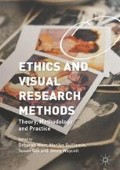Abstract
This chapter discusses 'mental mapping' as a visual research method and draws on a study of women immigrants who had moved to South Korea through commercially arranged marriages. Jung discusses the potential of the method, and particularly in promoting participants’ agency and authorship in research processes, that was countered by the circumstances of participants’ social vulnerability and powerlessness. In spite of efforts by the researcher to cede more power to the participants, and acknowledge them as co-producers of knowledge, this proved difficult for a range of reason including institutional expectations and the participants’ reluctance to be publically identified by family and neighbors. The researcher was pushed to navigate ethical and practical issues arising between anonymity and authorship, and develop flexible approaches for acknowledging authorship.
Access this chapter
Tax calculation will be finalised at checkout
Purchases are for personal use only
References
Cox, S., S. Drew, M. Guillemin, C. Howell, D. Warr, and J. Waycott. 2014. Guidelines for Ethical Visual Research, Methods. Melbourne: The University of Melbourne.
Downs, R., and D. Stea (ed.). 1973. Image and Environment: Cognitive Mapping and Spatial Behaviour. Chicago: Aldine.
Fuller, G., and M. Chapman. 1974. On the role of mental maps in migration research. International Migration Review 8(4): 491–506.
Gould, P., and R. White. 1974. Mental Maps. New York: Penguin Books Inc.
Haraway, D. 1988. Situated knowledges: The science question in feminism and the privilege of partial perspective. Feminist Studies 14(3): 575–599.
Hyams, M. 2004. Hearing girls’ silences: thoughts on the politics and practices of a feminist method of group discussion. Gender, Place and Culture 11(1): 105–119.
Jung, H. 2007. The spatial entrapment of women? On mobility of female transnational marriage migrants. Journal of the Korean Urban Geographical Society 10(2): 53–68. (in Korean).
———. 2012. Constructing scales and renegotiating identities: Women marriage migrants in South Korea. Asian and Pacific Migration Journal 21(2): 193–215.
———. 2014. Let their voices be seen: Exploring mental mapping as a feminist visual methodology for the study of migrant women. International Journal of Urban and Regional Research 38(3): 985–1002.
Kitchin, R., and S. Freundschuh (ed.). 2000. Cognitive Mapping: Past, Present and Future. London: Routledge.
Ley, D. 1972. The Black Inner City as a Frontier Outpost: Images and Behaviour of a North Philadelphia Neighborhood. Ph.D. Dissertation, Pennsylvania State University, University Park.
Lynch, K. 1960. The Image of the City. Cambridge: The MIT Press.
McIntyre, A. 2003. Through the eyes of women: photovoice and participatory research as tools for reimagining place. Gender, Place and Culture 10(1): 47–66.
McKay, D. 2002. Negotiating positioning: Exchanging life stories in research interview. In Feminist Geography in Practice: Research and Methods, ed. P. Moss. Oxford: Blackwell.
Miraftab, F. 2004. Can you belly dance? Methodological questions in the era of transnational feminist research. Gender, Place and Culture 11(4): 595–604.
Nagar, R. 2002. Footloose researchers, ‘traveling’ theories, and the politics of transnational feminist praxis. Gender, Place and Culture 9(2): 179–186.
Nazneen, S., A. Darkwah, and M. Sultan. 2014. Researching women’s empowerment: Reflections on methodology by southern feminists. Women’s Studies International Forum 45: 81–89.
Nencel, L. 2014. Situating reflexivity: Voices, positionalities and representations in feminist ethnographic texts. Women’s Studies International Forum 43: 75–83.
Phelan, S., and E.A. Kinsella. 2013. Picture this…safety, dignity and voice- ethical research with children: Practical considerations for the reflexive researcher. Qualitative Inquiry 19: 81–90.
Ponic, P., and N. Jategaokar. 2011. Balancing safety and action: Ethical protocols for photovoice research with women who have experienced violence. Arts & Health 4(3): 189–202.
Robson, S. 2011. Producing and using video data in the early years: Ethical questions and practical consequences in research with young children. Children and Society 25: 179–189.
Rose, G. 1997. Situating knowledges: Positionality, reflexivities and other tactics. Progress in Human Geography 21(3): 305–320.
Stapele, N. 2014. Intersubjectivity, self-reflexivity and agency: Narrating about ‘self’ and ‘other’ in feminist research. Women’s Studies International Forum 43: 13–21.
Tilley, L., and K. Woodthorpe. 2011. Is it the end of for anonymity as we know it? A critical examination of the ethical principle of anonymity in the context of 21st century demands on the qualitative researcher. Qualitative Research 11(2): 197–212.
Tsikata, D., and A. Darkwah. 2014. Research empowerment: On methodological innovations, pitfalls and challenges. Women’s Studies International Forum 45: 81–89.
Ungar, S. 2000. Cognitive mapping without visual experience. In Cognitive Mapping: Past, Present and Future, ed. R. Kitchin, and S. Freundschuh. London: Routledge.
Uttal, D., and L.S. Tan. 2000. Cognitive mapping in childhood. In Cognitive Mapping: Past, Present and Future, ed. R. Kitchin, and S. Freundschuh. London: Routledge.
Valentine, G. 2003. Geography and ethics: In pursuit of social justice-ethics and emotions in geographies of health and disability research. Progress in Human Geography 27(3): 375–380.
Wang, C. 1999. Photovoice: A participatory action research applied to women’s health. Journal of Women’s Health 8(2): 185–192.
Wiles, R., A. Coffey, J. Robison, and S. Heath. 2010. Anonymisation and Visual Images: Issues of Respect, ‘Voice’ and Protection. ESRC National Centre for Research Methods, NCRM Working Paper Series.
Author information
Authors and Affiliations
Editor information
Editors and Affiliations
Copyright information
© 2016 The Author(s)
About this chapter
Cite this chapter
Jung, H. (2016). Fuzzy Boundaries When Using “Mental Mapping” Methods to Trace the Experiences of Immigrant Women in South Korea. In: Warr, D., Guillemin, M., Cox, S., Waycott, J. (eds) Ethics and Visual Research Methods. Palgrave Macmillan, New York. https://doi.org/10.1057/978-1-137-54305-9_3
Download citation
DOI: https://doi.org/10.1057/978-1-137-54305-9_3
Published:
Publisher Name: Palgrave Macmillan, New York
Print ISBN: 978-1-137-54854-2
Online ISBN: 978-1-137-54305-9
eBook Packages: Literature, Cultural and Media StudiesLiterature, Cultural and Media Studies (R0)

